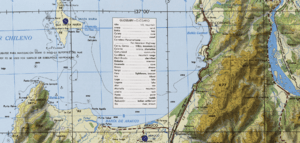Battle of Marihueñu facts for kids
Quick facts for kids Battle of Marihueñu |
|||||||
|---|---|---|---|---|---|---|---|
| Part of Arauco War | |||||||
|
|||||||
| Belligerents | |||||||
| Commanders and leaders | |||||||
| Strength | |||||||
| 180 Spanish soldiers and 1,400 to 2,100 indios amigos and six artillery pieces | 5,000 Mapuche warriors | ||||||
| Casualties and losses | |||||||
| 84 Spaniards and most of the indios amigos. All the artillery was captured. | unknown | ||||||
The Battle of Marihueñu was an important battle during the Arauco War. This war was a long conflict between the Mapuche people and the Spanish Empire in what is now Chile. The battle took place on February 23, 1554. It was fought between the Mapuche leader Lautaro and the Spanish general Francisco de Villagra. The Mapuche won this battle, showing their strength against the Spanish.
Contents
Preparing for the Battle
After a big loss at the Battle of Tucapel, the Spanish quickly got their forces ready again. They made their fort at La Imperial stronger. To do this, they left other places like Confines and Arauco. This helped them make the city of Concepción more secure.
The Mapuche people usually celebrated their victories for a long time. This meant Lautaro couldn't attack the Spanish right away. He wanted to take advantage of how weak the Spanish were. But the celebrations delayed his plans.
Gathering the Mapuche Army
It wasn't until February 1554 that Lautaro managed to gather a large army. He brought together about 8,000 Mapuche warriors. This was just in time to face the Spanish. General Francisco de Villagra was leading a group to punish the Mapuche.
Lautaro chose the hill of Marihueñu as the perfect spot for the battle. He planned his army very carefully. He divided his forces into four groups.
Lautaro's Clever Plan
Two of the Mapuche groups were meant to fight the Spanish first. Their job was to hold back the enemy and make them tired. Another group was kept hidden. This group would launch a fresh attack when the Spanish were about to give up.
The last group had a special mission. They were to cut off the Spanish escape route. A small team was also sent to destroy a bridge. This bridge was made of reeds and crossed the Bío-Bío River. Destroying it would make it even harder for Villagra's soldiers to retreat.
The Battle Unfolds
The Spanish attacked first and managed to break through the first Mapuche lines. But the third Mapuche group quickly moved in. Their fast action helped the Mapuche hold their ground.
Soon, the sides of this Mapuche group started to attack the Spanish from their flanks. This means they attacked from the sides. Then, the fourth Mapuche group attacked the Spanish from behind.
The battle lasted for many hours. The Spanish lost all their cannons. Only a small number of Spanish soldiers managed to escape. They had to fight very hard to break through the Mapuche who were blocking their way.
What Was the Result?
The Battle of Marihueñu was a major victory for the Mapuche. It showed their strong fighting skills and clever battle plans. This battle was an important moment in the long Arauco War.
See also
 In Spanish: Batalla de Marihueñu para niños
In Spanish: Batalla de Marihueñu para niños


